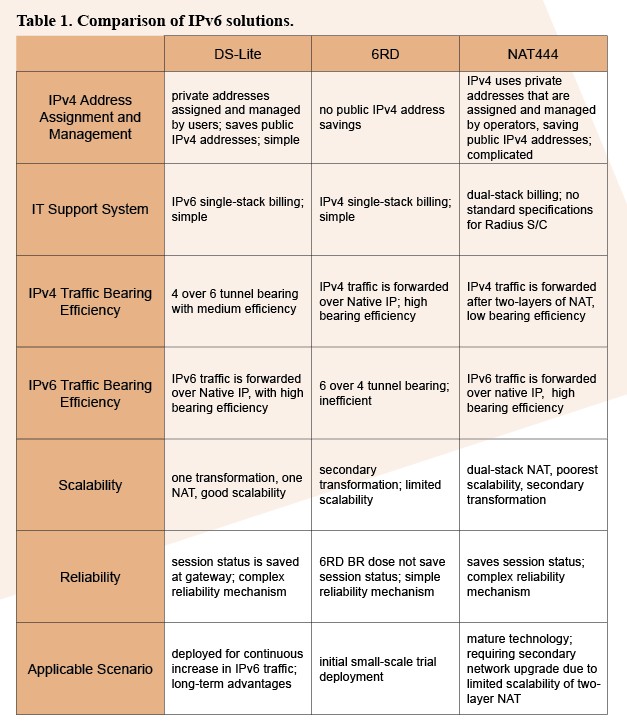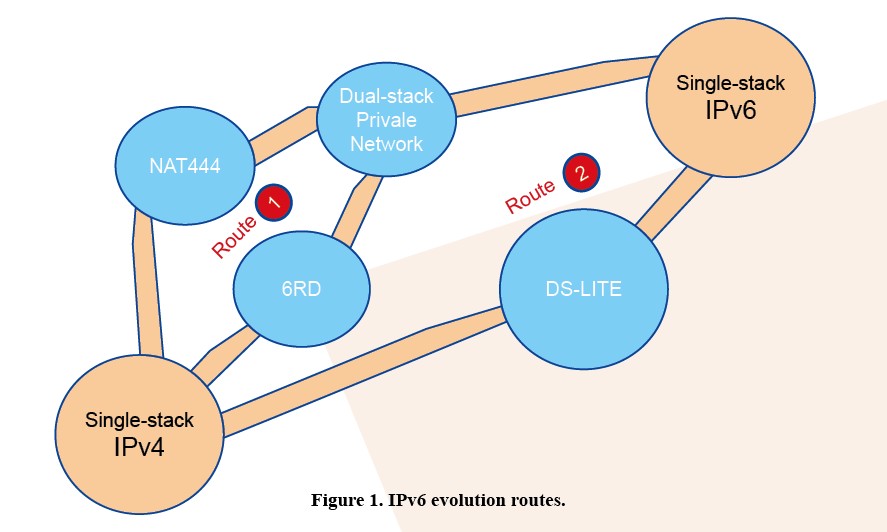IPv6 Evolution Solutions
In February 2011, the Internet Assigned Numbers Authority (IANA) announced that all the IPv4 addresses in the world had been assigned. IPv6 is the only available solution to IPv4 address shortage. Next-generation Internet based on IPv6 has an address space 1029 times that of the existing Internet. Root servers already support IPv6. Regional Internet registries are also accelerating their assignment of IPv6 addresses. The era of IPv6 is fast approaching.
It is assumed that IPv6 networks will be deployed before IPv4 addresses are exhausted, but this is not the case. First, ICPs may not be willing to rapidly upgrade their existing single-stack IPv4 equipment to dual-stack IPv6 equipment because they want to protect existing investments and save costs. Second, migrating existing IPv4 applications and services to IPv6 is a huge and complicated task, and different software, content, and service providers are involved. Such providers have not yet realized the impact of IPv4 address shortage on their networks and have little motivation to move to IPv6. Therefore, IPv4 and IPv6 will coexist on the Internet for a long time.
After years of evolution, IPv6 solutions now include DS-Lite, NAT444, and 6RD.
DS-Lite
DS-Lite allows IPv4 users to access IPv4 networks and services through an IPv6 access network. DS-Lite supports dual-stack customer premises equipment, and this allows IPv4 traffic to be forwarded to DS-Lite gateways through a 4-in-6 tunnel. Such a tunnel terminates at the DS-Lite gateway, where private-to-public network address translation (NAT) occurs. Unlike the two-layer NAT of NAT444, DS-Lite involves only one NAT. The DS-Lite gateway supports both a single-stack IPv6 access network and a dual-stack (IPv4 and IPv6) access network whereas NAT444 only supports a single-stack IPv4 access network.
6RD
6RD is a 6-in-4 tunneling technology. 6RD customer edge (CE) and 6RD border relay (BR) are dual-stack equipment that is compatible with an IPv4 network. When users initiate an IPv6 session, IPv6 packets reach 6RD CE and are encapsulated using an IPv4 header. They are then tunneled to 6RD BR. The encapsulated packets are decapsulated at the tunnel endpoint 6RD BR before being sent to end users over the IPv6 network.
NAT444
NAT444 has two layers of NAT: NAT1 and NAT2. NAT1 is located between two private IPv4 addresses, and NAT2 is located between a private and a public IPv4 address: IPv4–NAT1–IPv4–NAT2–IPv4. In this way, ICPs can significantly reduce the demand for public IPv4 addresses. By deploying private addresses at both the user side and access network, ICPs can save a large number of public IPv4 addresses. For ICPs with very limited IPv4 address resources, the NAT444 solution comes at the right time. Very few changes need to be made to the existing network, and there is no need for large-scale network transformation. New users and newly built access networks can deploy NAT444 gateways.
IPv6 Evolution Routes

ZTE has proposed two IPv6 evolution routes. ICPs that have a shortage of IPv4 addresses can select route 1 to relieve the shortage first and deploy 6RD at the same time for dual-stack private networks. They can bring in IPv6 services, develop IPv6 product chains, promote IPv6 user development, and explore IPv6 operation and management. When the IPv6 industry chain is mature, they can gradually transition to single-stack IPv6.
ICPs that do not have an urgent need for IPv4 addresses can select route 2. They can deploy DS-Lite to avoid an upgrade for the poor scalability of the two-layer NAT.
ICPs can flexibly determine routes according to the characteristics of the route. For areas where network infrastructure is in good condition and existing network equipment can be easily upgraded to IPv6, route 2 is appropriate. For areas with old equipment where it is difficult to upgrade to IPv6 upgrade, route 1 is appropriate.

ZTE's IPv6 Solution
ZTE was one of the first Chinese companies to adopt and promote IPv6 technology. ZTE has developed a full range of IPv6 products and solutions to enhance the network experience of ICPs and users. In 2009, ZTE participated in France Telecom’s IPv6 project. Since then, ZTE's T8000, M6000, and M6000-S have performed well in trials conducted by operators worldwide. These products have been added to the purchase lists of France Telecom and other global operators.
Smooth Network Upgrade
ZTE's IPv6 solutions support DS-Lite, NAT444, NAT64, Smart6, and 6RD, which are technologies for transitioning from IPv4 to IPv6. This allows for smooth network upgrade.
ZTE provides three-slot, five-slot, eight-slot, and sixteen-slot IPv6 products to support standalone CGN and embedded CGN. Users can choose products according to their transition time and service scale. This helps reduce TCO.
Improved User Experience
ZTE's solutions support NAT ALG technologies such as SIP, FTP, H323, ICMP, RTSP, DNS, and PPTP. This allows TCP traversal, caused by NAT technologies, to be overcome.
M6000 CGN tracing technology is designed to overcome the weakness of NAT technologies in user positioning. It also allows for normal operation and expansion of services.
M6000 CGN hot standby guarantees high performance, capacity, and reliability of services delivered to users. It enhances network and user experience and strengthens an operator's brand.